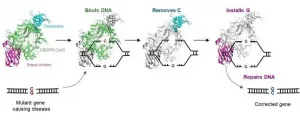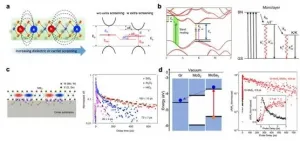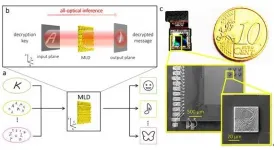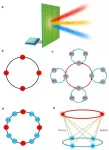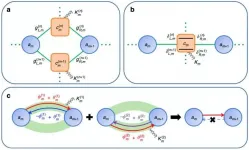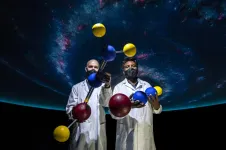INFORMATION:
Lithium niobate crystal film for integrated photonic applications
2021-03-11
(Press-News.org) In contemporary society, the demand for high-bandwidth optical communication, including mobile high-definition videos, autonomous vehicles, remote surgery, telepresence, and interactive 3D virtual reality gaming, is sharply increasing. The electro-optical modulator is the key component for optical fiber communication, which modulates the light signal for loading information through electricity. Lithium niobate (LiNbO3, LN) exhibits a high-performance electro-optic effect and high optical transparency. On the other hand, the ferroelectric domain engineering on LN crystals has been extended from 1D to 2D and 3D. Moreover, considering the device size, reliability, cost, and energy consumption, the photonic integrated circuit (PIC) technology has recently gained signi?cant interest in the rise of the integrated photonics field. Integrated photonics is concerned with the integration of all the key components connected by a waveguide in a single chip (photonic platform) using a single material (monolithic integration) or multi-materials (hybrid integration). Over the past 25 years, integrated lithium niobate photonics have relied almost exclusively on the high-quality lithium niobate thin film on insulator (LNOI) technology and advanced PIC technology for etching nanophotonic waveguides and microphotonic modulators. Lithium niobate has launched a photon revolution as silicon did for electronics. Herein, we review the progress of microstructure engineering and domain engineering of LNOI for integrated lithium niobate photonics, including photonic modulation and nonlinear photonics.
For photonic modulation, both the complementary approaches of microstructure engineering for photonic circuits, i.e., the direct etching of LNOI (monolithic integration) and other photonic materials rib-loaded on LNOI (hybrid integration), are reviewed. The sub-wavelength waveguides with a low propagation loss of 2.7 dB/m as well as an ultra-high Q of 5 × 106 have been fabricated by direct etching on a LNOI platform. Furthermore, The integrated MZI modulator with a small size of several millimeters on a x-cut LNOI exhibited a very high bandwidths of up to 100 GHz. The smart cut method for the preparation of wafer-scale LNOI samples (NanoLN, Jinan Jingzheng Electronics Co., Ltd.) greatly promoted the development of integrated lithium niobate photonics. the substitution of z-cut LN film by a x-cut LN film greatly promoted the integration level of photonic circuits. The channel patterns with electrodes were easily transferred into a x-cut LN film, while the bottom electrode generally occupy the whole plane for a z-cut LN film. Importantly, the gold electrodes can be placed very tightly from the edge of a resonator on a x-cut LN film, which results in strong phase modulation without affecting the Q factor.
In addition, the hybrid integration of photonic materials with a LN film is an effective approach for the integrated photonics, which can avoid the etching of LN. However, no matter the LN film works as top cladding or substrate, the transition loss between the two layers is still a problem for this hybrid waveguide. Though the design of VACs nearly resolved the problem of transition loss, the nanophotonic LN waveguide was still adopted and the waveguide parameters must be precisely controlled for high modulation efficiency and low optical loss. It doesn't fully reflect strengths of hybrid integration which avoids the etching of LN. Therefore, the approach of hybrid integration still needs further improvement.
High-efficiency, compact, and integration-compatible wavelength converters using optical waveguides involve nonlinear integrated photonics. Generally, photonic microstructures used for frequency conversion are designed based on a stronger mode confinement because the nonlinear effect can significantly enhance inside a small modal volume due to the increased field strength and temporal confinement of the interacting modes. Metasurfaces consisting of nanoantennas are often used for enhanced optical nonlinearities. A nanophotonic LN waveguide patterned with gradient metasurfaces was fabricated to achieve a monotonic increase in SHG power, resulting in a high-efficiency SHG of approximately 1000% W?1 cm?2, which is three orders of magnitude more efficient than the bare LN waveguide. However, the obvious phase mismatch between the interacting waves often results from material dispersion. Therefore, several phase-matching techniques as well as the associated waveguide microstructure engineering have been explored for second harmonic generation (SHG) processes. Recently developed the integrated frequency-conversion devices on PPLN films also involved hybrid and monoclinic approaches. Generally, the phase-matching condition is a critical factor in nonlinear frequency conversion processes. However, the phase-matching-free SHG has been achieved with high-efficiency conversion by the gradient metasurface on an on-chip integrated nonlinear photonic device. This found will promote the development of nonlinear integrated photonics on LNOI. Of course, many integrated nonlinear photonic devices were fabricated by following the phase-matching SHG, especially quasi-phase-matching. The preparation of PPLN film greatly promoted the nonlinear integrated photonics on LNOI, especially the nanophotonic PPLN waveguides which realized a conversion efficiency of up to 4600% W-1 cm-2. In the future, the nanophotonic PPLN waveguides will be applied in quantum technology to develop the integrated quantum technology.
Over the last decade, integrated lithium niobate photonics has rapidly developed and proved invaluable in the development of future optical communication and quantum technologies. The large-scale and low-cost manufacturing of integrated photonic devices and systems by mature manufacturing processes will enable new revolutionary applications in optical communication and quantum technologies.
ELSE PRESS RELEASES FROM THIS DATE:
Singapore scientists develop novel gene editor to correct disease-causing mutations
2021-03-11
A team of researchers from the Agency for Science, Technology and Research's (A*STAR) Genome Institute of Singapore (GIS) have developed a CRISPR-based gene editor, C-to-G Base Editor (CGBE), to correct mutations that cause genetic disorders. Their research was published in Nature Communications on 2 March 2021.
One in seventeen people in the world suffers from some type of genetic disorder. Chances are, you or someone you know - a relative, friend, or colleague - is one of approximately 450 million people affected worldwide. Mutations responsible for these disorders can be caused by ...
Healthy Diet Index supports diet quality assessment and dietary counselling in healthcare
2021-03-11
The Healthy Diet Index developed by Finnish nutrition experts facilitates the assessment of diet quality. Its effectiveness was demonstrated in a recently published study.
Dietary counselling plays a crucial role in the prevention and treatment of chronic lifestyle diseases. In healthcare settings, dietary counselling is often provided by professionals without specific training in nutrition, and there is a demand for tools for reliable and easy assessment of diet quality. One such tool is the Healthy Diet Index developed in the recently completed Stop Diabetes (StopDia) project.
The Healthy Diet ...
Children's dietary guidelines need to change, experts say
2021-03-11
Dietary and infant feeding guidelines should be strengthened to include more practical advice on the best ways to support children to learn to like and eat vegetables, say nutrition and dietetics researchers from the Flinders University Caring Futures Institute.
With the Australian Health Survey showing only 6% of children aged 2-17 years are eating the recommended amount of veggies, experts say more tailored practical advice is needed on how to offer vegetables to young children through repeated exposure and daily variety in order to increase their intake.
A recent paper co-authored by researchers from Caring Futures Institute and CSIRO, Australia's national ...
Dry eye disease negatively affects physical and mental health as well as vision
2021-03-11
Patients suffering from dry eye disease symptoms have a lower quality of life compared to those without symptoms, a new study reports. The findings showed that patients with the condition reported negative effects on visual function, their ability to carry out daily activities and their work productivity.
Dry eye disease is a common condition and a frequent reason for patients to seek medical care. It can affect people of any age but is most prevalent in women and in older people. Symptoms include irritation and redness in the eyes, blurred vision, and a sensation of grittiness or a foreign body in the eye. It has been reported that up to a third of adults over 65 years old have the condition, although the actual number is likely to be higher as there is no established ...
Modulation of photocarrier relaxation dynamics in two-dimensional semiconductors
2021-03-11
Two-dimensional (2D) semiconductors can host a rich set of excitonic species because of the greatly enhanced Coulomb interactions. The excitonic states can exhibit large oscillator strengths and strong light-matter interactions, and dominate the optical properties of 2D semiconductors. In addition, because of the low dimensionality, excitonic dynamics of 2D semiconductors can be more susceptible to various external stimuli, enriching the possible tailoring methods that can be exploited. Understanding the factors that can influence the dynamics of the optically-generated excited states represents an important aspect of excitonic physics in 2D ...
AI holographic nanostructures on CMOS chips for energy-efficient security schemes
2021-03-11
Today, machine learning based methods are of our everyday life, with millions of users every day unlocking their phones through facial recognition or passing through AI-enabled automated security checks at airports and train stations. Traditionally, the processing of information native to the optical domain is being executed in the electronic domain, requiring energy-hungry specialized electronic hardware and conversion between the two realms. Optical machine learning is emerging as an important field, where the processing of optical information is done directly within the optical domain, power-efficient and at the speed of light.
Machine learning tasks, such as pattern recognition or image classification, rely heavily on the multiplication of large matrices, a resource-hungry ...
Information transition mechanisms of spatiotemporal metasurfaces
2021-03-11
Spatiotemporal metasurfaces, driven by ultrafast dynamic modulations, opened up new possibilities for manipulating the harmonic modes of electromagnetic waves and generations of exotic physical phenomena, such as dispersion cancellation, Lorentz reciprocity broken, and Doppler illusions. In recent years, rapid development of information technologies have stimulated many information processing applications for metasurfaces, including computational imaging, wireless communications, and performing mathematical operations. With increasing amount of researches focused on the topic of information processing ...
Loss induced nonreciprocity
2021-03-11
Optical nonreciprocity, which prohibits the light field returning along the original path after passing through the optical system in one direction, is not only of vast interest to fundamental science, which brings us a deeper understanding of Lorentz reciprocity, time-reversal symmetry, and topological effects, but is also of great importance for realizing nonreciprocal optical and electromagnetics devices such as isolators, circulator and directional amplifiers, which are indispensable for applications ranging from optical communication to optical information processing.
However, realizing nonreciprocity is rather difficult as it requires breaking of the Lorentz reciprocity ...
Uncovering exotic molecules of potential astrochemical interest
2021-03-11
Looking at the night sky, one's thoughts might be drawn to astrochemistry. What molecules inhabit the vast spaces between the stars? Would we see the same molecules that surround us here on Earth? Or would some of them be more exotic--something rarely observed or even unknown?
Recent research by a multinational team led by Prof. Robert Ko?os from the Institute of Physical Chemistry of the Polish Academy of Sciences has revealed an unusual molecule obtained and detected for the first time in laboratory conditions and also paved a smooth path to produce and further study another. Now that they can be seen and studied, they may prove worthy ...
Optimal design for acoustic unobservability in water
2021-03-11
Until now, it was only possible to optimize an acoustic cloaking structure for the air-environment. However, with this latest research, Acoustic cloak designed by topology optimization for acoustic-elastic coupled systems, published in the latest Applied Physics Letters, it is possible to design an acoustic cloak for underwater environments.
In the conventional topology optimization of acoustic cloaking, the design method was based on an analysis that approximated an elastic body in the air as a rigid body. However, since the approximation holds only for materials that are sufficiently ...

